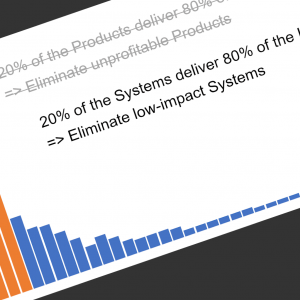Few cloud computing vendors are able to produce a plausible cost model with any level of detail. All of your SMB customers are asking the same question, so why don't you have a simple, clear, canned answer? In the absence of a vendor model, this article will help you quickly work up the big chunks of the opportunity in short order.
Cloud is another one of those buzzwords that lots of people have heard about, and not everyone fully understands. I have been asked by GMs, MDs and leaders of small- to medium-sized businesses((Lots of people also toss around the SMB acronym, and depending on who you are talking to (vendors, economists, or People with Strong Opinions), it can refer to businesses with annual revenues in the $10M-250M range, or organizations in the $500M-2B range. I don’t really know of any hard and fast rule myself, but for this article, I am talking about firms ranging from $50M-500M, with five or fewer physical locations (manufacturing / distribution, plus sales offices).)) about the possibilities with cloud – but to be fair, their interest is primarily in the cost reductions so breathlessly promised by press and providers. Their mindset is firmly set in classic manufacturing, local distribution, and [non-technical] professional services that are typically run lean, especially for IT support of back-office functions.
Of course, every situation is unique, but I typically talk with folks that have a fairly mature business system in place – ERP for the manufacturing and distribution folks, maybe some basic project management and customer data (CRM systems, plus drawings, quotes, etc.). And of course, eMail and shared folders on the network – everyone’s default knowledge and data store, Collaboration 0.5. “Mature” systems and “lean” organizations often mean a fairly small supporting IT staff, with barely enough time in the day to get their basic support and maintenance work done, let alone contribute some tech and data expertise to support the company’s key objectives.
For these folks, the common hope is to “move my systems to the cloud”, and cut operating expenses in half, or even more. I’m actually being a little conservative with those figures – I’ve heard stories of vendors promising 80% cost reductions and more. Pretty aggressive targets – but where exactly are we assuming those savings are coming from? Surprisingly, few vendors are able to produce a plausible cost model with any level of detail. This just amazes me; all of your SMB customers are asking the same question, so why don’t you have a simple, clear, canned answer?
I’m “amazed” because I believe it’s possible – without too much effort. In the absence of a vendor model, you can quickly work up the big chunks of the opportunity in short order. Here’s how the basic argument for moving portions of the back office and customer-facing systems to the cloud might go:
- IT must deliver basic services XXX so the overall business can operate each day
- The business needs their IT team to work on new capabilities YYY (and generate value $AAA), but there is no time available (see #1)
- Proposal is to move servers, storage, backup, and other basic functions to a cloud provider or external data center, at incremental cost of $BBB
- Result will be that IT moves responsibility for XXX to someone else, and frees up time to work on YYY
- (summary) For the incremental cost of $BBB, you get new capabilities YYY
That last one is the basic value proposition – we will be paying incremental dollars to free up existing resources, so they can work on value-adding projects.
I Thought We Are Reducing Costs
As I mentioned before, the challenge with SMBs is that they are typically quite thin on resources as it is. Unlike IT groups in larger shops, these SMB tech groups are typically a very small number of jack-of-all-trades types, expected to fix the copiers, back up the servers, and do all of your data extracts and reporting. It’s going to be tough to reduce headcount when the few folks you have are doing a little bit of everything – and you’ll still get no incremental value, it will just be a cost shift.
It’s still a valid proposition – if the incremental cost of $BBB is not deemed too much to pay for new capabilities YYY. And, you have to work up the details …
- Make sure to understand and include all the costs that you are moving to an outside provider – purchasing, server builds, patching, monitoring, backup, troubleshooting.
- Don’t forget to list out “soft” benefits – more reliable backups, better Disaster Recovery capabilities, improved engineering talent watching your servers
- Remember that there may be some re-skilling involved – your IT group may include a few “server huggers” who do not wish to lose the tech that requires their skill set. Remind them this change will bring the opportunity to learn new skills that drive the business forward – and will make them more valuable than before.
- Don’t assume that the amount of time currently spent doing this work internally will be 100% freed up; you must devote a decent chunk of time to Vendor Management – watching and monitoring your service levels and addressing the inevitable hiccups. You cannot underestimate the importance of this.
25 August, 2014







This Post Has 0 Comments